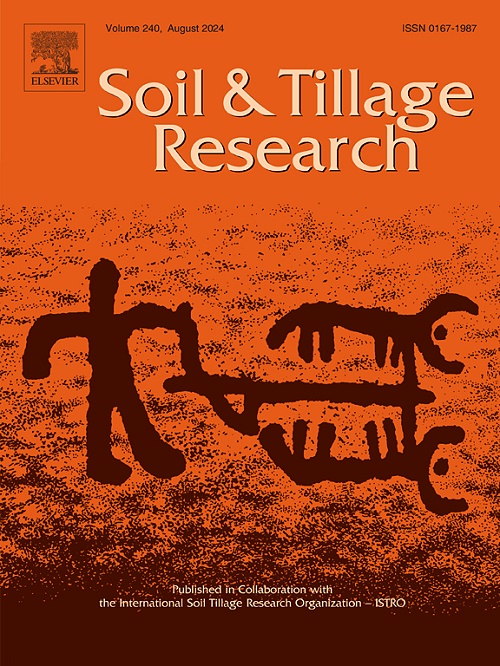Advances in soil heating experimentation: A novel methodological framework for laboratory studies
IF 6.1
1区 农林科学
Q1 SOIL SCIENCE
引用次数: 0
Abstract
Studies using controlled soil heating in the laboratory make it possible to understand and portray different scenarios of fire severity in the soil. However, some laboratory soil heating techniques do not maintain some field variables that are indispensable in heating and heat transmission through the soil and may underestimate the real severity of heating. This study aims to propose a new method for fire simulation, considering influence factors that are closer to the reality of natural fires. For that purpose, undisturbed samples were taken at 0–5 cm depth from Red-Yellow Ferralsol (n = 52) and Haplic Cambisol (n = 52) in the Vila Velha State Park – Paraná states - southern Brazil. The samples were experimentally heated in a conventional electric oven with internal air circulation based on three real field variables: oven temperature (100; 200; 300ºC), plant litter cover (absent and present), and soil moisture (<5 and 15–20 %), composing a 2x3x2 × 2 factorial scheme (n = 4). During heating, soil surface temperature was measured using thermocouples. The Kruskal-Wallis test was applied, followed by the Dunn test (p < 0.05), considering the asymmetric and non-normalized distribution of the variables. The final temperatures reached in both soils varied between 36.3 and 220.0°C, being reduced when moisture was higher, plant litter cover was present, and sand content was lower. In this test, therefore, the most influential factors in soil heating were the applied temperature and vegetation cover. The positive points of the proposed method are: 1) associating two or more factors in controlled experiments; 2) quantifying the magnitude of influence for individual or combined factors; 3) contributing to decision making regarding the proper moment to apply controlled fire, once the effects at different conditions of moisture, soil cover and type are identified; and 4) evaluating the realistic effects of low and medium intensity natural fire heating on soil properties.
土壤加热实验的进展:实验室研究的新方法框架
在实验室中使用受控土壤加热的研究可以理解和描绘土壤中火灾严重程度的不同情景。然而,一些实验室土壤加热技术没有保持一些在加热和热通过土壤传递中不可或缺的现场变量,可能低估了加热的实际严重程度。本研究旨在提出一种新的火灾模拟方法,考虑更接近自然火灾现实的影响因素。为此,在巴西南部帕拉纳州维拉维拉州立公园的红-黄Ferralsol (n = 52)和Haplic Cambisol (n = 52)中,在0-5 cm深度处采集了未受干扰的样品。根据三个实际场变量:烤箱温度(100℃;200年;300ºC)、植物凋落物覆盖度(无凋落物和有凋落物)和土壤湿度(<;5和15-20 %),构成2x3x2 × 2因子方案(n = 4)。在加热过程中,用热电偶测量土壤表面温度。考虑到变量的非对称分布和非归一化分布,采用Kruskal-Wallis检验,然后采用Dunn检验(p <; 0.05)。两种土壤的最终温度在36.3 ~ 220.0℃之间变化,当湿度较高、有凋落物覆盖、含沙量较低时,最终温度会降低。因此,在本试验中,对土壤加热影响最大的因子是施用温度和植被覆盖。该方法的优点是:1)在对照实验中关联两个或多个因素;2)量化单个或组合因素的影响程度;3)一旦确定了不同湿度、土壤覆盖和类型条件下的影响,有助于决策适当的灭火时机;4)评价中、低强度自然火加热对土壤性质的现实影响。
本文章由计算机程序翻译,如有差异,请以英文原文为准。
求助全文
约1分钟内获得全文
求助全文
来源期刊

Soil & Tillage Research
农林科学-土壤科学
CiteScore
13.00
自引率
6.20%
发文量
266
审稿时长
5 months
期刊介绍:
Soil & Tillage Research examines the physical, chemical and biological changes in the soil caused by tillage and field traffic. Manuscripts will be considered on aspects of soil science, physics, technology, mechanization and applied engineering for a sustainable balance among productivity, environmental quality and profitability. The following are examples of suitable topics within the scope of the journal of Soil and Tillage Research:
The agricultural and biosystems engineering associated with tillage (including no-tillage, reduced-tillage and direct drilling), irrigation and drainage, crops and crop rotations, fertilization, rehabilitation of mine spoils and processes used to modify soils. Soil change effects on establishment and yield of crops, growth of plants and roots, structure and erosion of soil, cycling of carbon and nutrients, greenhouse gas emissions, leaching, runoff and other processes that affect environmental quality. Characterization or modeling of tillage and field traffic responses, soil, climate, or topographic effects, soil deformation processes, tillage tools, traction devices, energy requirements, economics, surface and subsurface water quality effects, tillage effects on weed, pest and disease control, and their interactions.
 求助内容:
求助内容: 应助结果提醒方式:
应助结果提醒方式:


